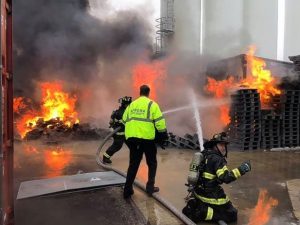Because damage can be widespread and severe, responders need effective and rapid consequence modeling of the hazardous materials emanating from a fire.
Fire and explosion accidents are of major concern to the owners and operators of refineries and petrochemical, gas processing, terminal, and offshore facilities. Statistics have shown that the majority of monetary loss in these types of complexes is due to fire and explosion.
According to statistics, 77 percent of the monetary loss in refinery and petrochemical complexes is due to fire and explosion.1 The breakout of accidents due to fire and explosion is 65 percent vessel (container) and vapor cloud explosion and 35 percent fire. The causes of these accidents are mostly attributed to mechanical issues, process upset, and operator error.
Fire in an industrial setting can pose a number of hazards for the facility, its personnel, and the surrounding communities and can result in an assortment of damage. The release of a flammable material may result in several scenarios: a fireball, pool fire, flash fire, flare or jet fire, and an unconfined vapor cloud explosion.
Two of the main inherent hazards associated with fires are thermal radiation and smoke. Smoke is defined as the products of combustion, including toxic gases, water vapor, and carbon soot particles. The smoke created from fire poses two types of danger. Soot particles may obscure visibility, and hazardous chemicals may constitute a health hazard due to inhalation and eye irritation.
A fire also may present indirect hazards. One is its possible impingement on a vessel containing liquid, such as a large storage tank. In this circumstance, a condition called BLEVE (Boiling Liquid Expanding Vapor Explosion) may occur. Boilover is a second indirect hazard caused by the effects of a fire. Boilover is especially dangerous when water is used to put out oily hydrocarbon liquid fires from a vessel. In the following paragraphs, we describe each of the above items in more detail.
 Types of Fire Hazards
Types of Fire Hazards
Thermal radiation. One of the main dangers of fire is its thermal radiation and the effect of that radiation on people and property. Thermal radiation diminishes with the inverse square of distance. The American Petroleum Institute and TNO, a Dutch research group, have published books explaining how to estimate the thermal radiation impact and the radiation’s estimated damage potential based on distance from a fire. According to these guides, the thermal radiation necessary to generate second degree burns on exposed skin is 9500W/m2 (~370 C), given an exposure duration of more than 20 seconds.
Smoke. Fires generate smoke, which is a mixture of soot particles, toxic gases, and water vapor. Factors such as smoke yield, fire size, particle size, and ambient conditions dictate smoke’s transport into the environment. Studies show that soot particles can be generated in a range of 0 to 20 percent of fuel by weight during a pool fire. However, the air-to-fuel ratio and the amount of carbon in the molecular structure of chemicals play a major role in soot yield.
A higher soot rate is expected for a large pool fire with heavy hydrocarbon fuels. Soot particles in a range of 0.01 to 10 microns are respirable and can penetrate into the alveolar region of the lungs. A mean soot particle size for the majority of these fuels can be considered 5 microns. The generated soot particles may adsorb toxic gases from the products of combustion, which present public health concerns due to the inhalation potential of these toxic particles. Given this, the downwind dispersion and deposition of these particles and their effects on the environment and humans is of major concern.
For example, consider a pool fire of 4500 Kg crude oil in a diameter of 40 meters that generates a soot particle plume. The soot particles yield a maximum of 20 percent of crude oil mass. The weather conditions are assumed to be unstable with a wind speed of 5 m/s and ambient temperature of 70º F.
Soot particle concentrations are considered in the three isopleth levels of 1, 10, and 100 mg/m3. In this case, the soot particles are rising to high elevation due to high temperature and buoyancy. Thereafter, the soot particle plume starts to touch the ground about 1,200 meters distance from the fire source. In this example, calculations show soot particles can expose a region of 4,500 meters distance, after two hours of simulation, which would represent the area to be notified of possible evacuation or shelter-in-place.
Ground-level soot particle deposition occurs in a wide area with a distance of 8,000 meters. The isopleth concentrations on the ground are defined in the three levels of 1, 10, and 100 mg/m2. This mapped information helps hazmat and emergency responders to identify the high impact areas of soot particle deposition for immediate evacuation. However, it should be noted that wind speed and direction, pool fire size, soot yield, and soot particle size can change the impact of the soot plume on the environment and the population located near the fire.
Deliberate ignition
Fire can sometimes be a great tool for mitigating a hazardous chemical’s potential impact. The technique of igniting gases containing hazardous chemical substances has been successfully used for many years at oil and gas well sites. A prime example is the sour gas from wells; considerable amounts of hydrogen sulfide (H2S) are contained in the natural gas.
Hydrogen sulfide smells like rotten eggs and is extremely toxic and irritating, even in a lower concentration such as 100 ppm. The dispersion of 40,000 ppm H2S in the sour gas can create a large hazard zone in the ambient. However, igniting the sour gas will produce CO2, CO, and a small amount of SO2, plus unburnt H2S, with no ground-level impact of the H2S. Therefore, fire can sometimes serve as an effective mitigation technique for hazard reduction.
BLEVE (Boiling Liquid Expanding Vapor Explosion)
BLEVE is a phenomenon that is caused by an external fire impinging on a storage vessel, causing the heating of the liquid contents with a resulting pressure buildup. If the vessel’s relief valve is not designed to vent the vapor as fast as it is generated or the relief valve malfunctions, then the vessel may fail completely, resulting in an explosion with vessel fragments being projected over the surrounding area. These fragments have the real potential to puncture pipes or other vessels in the vicinity of the explosion, causing a domino effect. Fragment projectiles traveling distances of up to one mile have been reported in a BLEVE.
Boilover
When fighting semi-enclosed oil or petrochemical fueled fires using water, a secondary hazardous event called boilover may occur that is extremely dangerous. Some of the water will sink to the bottom of the tank or other vessel due to density differences, which will result in the formation of a water layer. The heat from the fuel will ultimately boil the water, creating steam. The rapidly expanding steam expels the fuel upward to boil over and out of the container, discharging the still-ignited fuel onto a large and uncontrolled area outside the container. The best way to prevent this phenomenon is to open the valve at the bottom of the tank to drain the water.
A common household example of this phenomenon can occur when water is used to put out a burning pan of cooking oil.
Vessel Venting/Flare
When dealing with a vessel that is about to explode, one option is to vent and burn the discharging material, basically turning the explosive event with its uncontrolled disaster potential into fire which has a lower hazard impact and is more controllable.
Conclusion
This article has exposed the many faces of fire hazards and fire damage possible in an industrial setting. The details presented highlight the need for effective and rapid consequence modeling of hazardous materials emanating from a fire. Such modeling can help firefighters, hazmat teams, and other emergency responders properly study and better understand the impact of the many hazards associated with fire, such as thermal radiation, toxic smoke, and particulates, thus enabling better situational analysis and more informed decision making during and after a fire event.
Such analysis and decision making permits faster life-saving measures to be undertaken regarding evacuation, shelter-in-place, and other essential response actions. In the end, these measures help to reduce the potential for injury, loss of life, and property and environmental damage.

